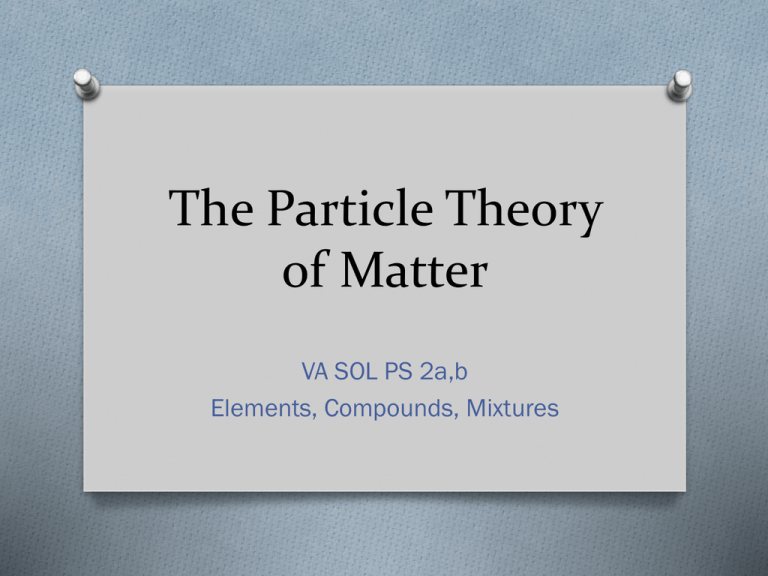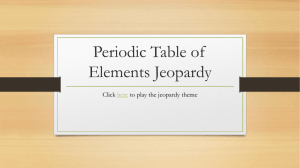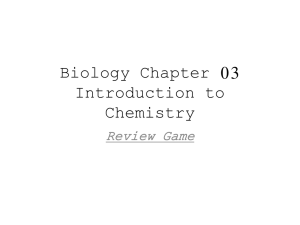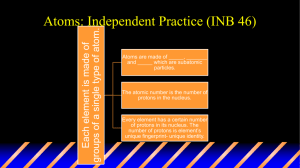The Particle Theory of Matter
advertisement

The Particle Theory of Matter VA SOL PS 2a,b Elements, Compounds, Mixtures What is the smallest particle? Video hyperlink O A piece of sand? O A bit of dust floating in the air? O What is it made of? O If it is too small for you to see, does it still exist? O School microscope? Electron microscope? O Divide that dust into a hundred pieces O A thousand pieces? A millions pieces? O A BILLION pieces?? Sub-Atomic Particles The Atom O The basic particle from which all elements are made O Elements are pure substances that can be found on Earth. O An atom is one particle of an element O 92 elements occur naturally, 26 more have been produced in science labs O Ex: oxygen, gold, sulfur Nanoscale! Quarks O There are particles even smaller than atoms, but they don’t make elements – they make atoms! O Those smaller particles are O Quarks – they have really weird names! O Up, Down, Top, Bottom, Strange, & Charm O Leptons O Electron, Muon, Neutrino, & Tau Proton O 2 up quarks and 1 down quark make a proton O Proton – the most important particle in an atom O The number of protons in an atom determine which element it is. Called atomic number O 1 proton = hydrogen O 6 protons = carbon O 8 protons = oxygen O 26 protons = iron O Has a positive electrical charge (+) Neutron & Isotope O 2 down quarks and 1 up quark make a neutron O Neutron – found in nucleus of atom with proton O A neutron does not have an electrical charge – neutral O The number in a nucleus can change. O Carbon 12 = 6 protons & 6 neutrons O Carbon 13 = 6 protons & 7 neutrons O Carbon 14 = 6 protons & 8 neutrons O Called isotopes (like flavors of ice cream) O When they are not equal, this causes the atom to be radioactive – it breaks apart Electron & Ion O Electrons are not made of anything smaller O Has a negative electrical charge (-) O There is usually 1 electron for every proton O 1 proton + 1 electron O Like neutrons, that number can change O When an atom loses or gains an electron, it is no longer called an atom, it is now an ion. O Losing an electron makes the atom have a positive charge (+). Its called a cation. (ACID) O Gaining an electron makes the atom have a negative charge (-). Its called an anion. (BASE) Nucleus O Protons and neutrons are together in the center of the atom. O It is called the nucleus O Electrons spin rapidly around the outside of the nucleus. O They form layers – like the layers of an onion O These layers are called “orbital shells” Atomic Structure Nucleus Molecule O Whenever 2 or more atoms are connected, it is called a molecule O It can be 2 or more atoms of the same element O O is an atom of oxygen O O2 is a molecule of oxygen O Or it can be 2 or more elements of a different element O CO2 is a molecule of carbon dioxide Compound O When 2 or more atoms of different elements are hooked together, it is called a compound O 2 atoms of hydrogen + 1 atom of oxygen = a molecule of H2O (water) O 1 atom of sodium + 1 atom of chlorine = a molecule of sodium chloride (NaCl or salt) O These are chemically bonded together. They can not be physically separated O Only a chemical reaction can break the bonds Mixture O Mixtures are 2 or more elements or compounds that are physically mixed together O They can be easily separated O There are 2 kinds of mixtures O Heterogeneous mixtures – you can see the different substances. Ex: Trail Mix, a salad, or a messy locker O Homogeneous mixtures – you cannot see the different substances. Ex: Kool-Aid, milk, or air Solution O Solutions are a type of homogeneous mixture O When one substance is dissolved in another O Ex: sugar dissolved in water O Solvent – what does the dissolving (water) O Solute – what gets dissolved (sugar) O Water dissolves more substances than anything else O Called the Universal Solvent Solubility O Solubility is a measure of how much solute can dissolve in a solvent O Ex: how much sugar can dissolve in water? O Affected by temperature O Hotter? More sugar will dissolve O Colder? Less sugar will dissolve O A solution is saturated when no more solute will dissolve in the solvent O If hot sugar water with a LOT of sugar in it is cooled down, then the sugar will precipitate out (fall down)






